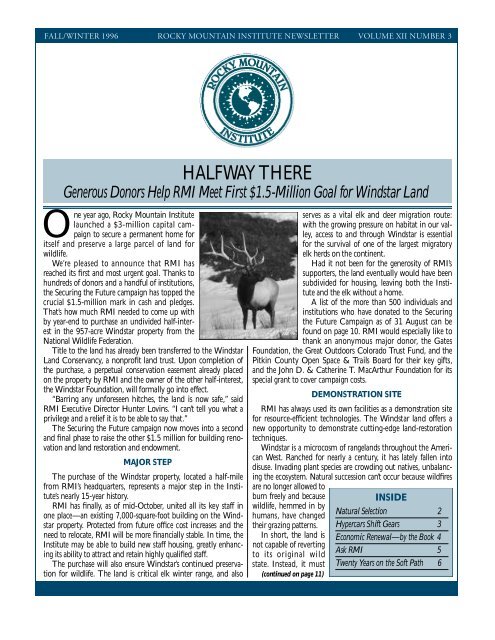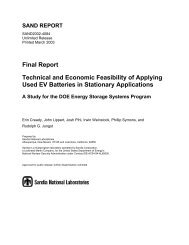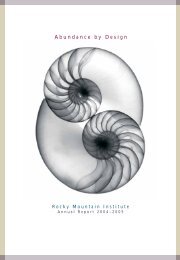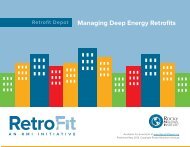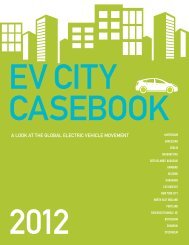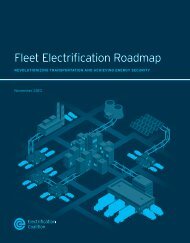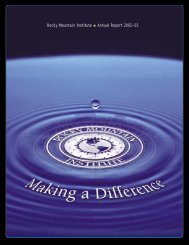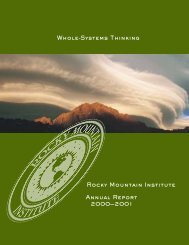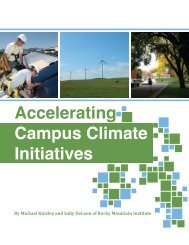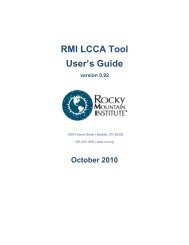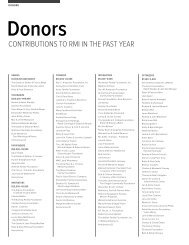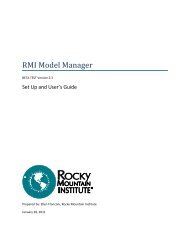RMI Newsletter, Fall/Winter 96 - Rocky Mountain Institute
RMI Newsletter, Fall/Winter 96 - Rocky Mountain Institute
RMI Newsletter, Fall/Winter 96 - Rocky Mountain Institute
You also want an ePaper? Increase the reach of your titles
YUMPU automatically turns print PDFs into web optimized ePapers that Google loves.
FALL/WINTER 19<strong>96</strong> ROCKY MOUNTAIN INSTITUTE NEWSLETTER VOLUME XII NUMBER 3H A L F WAY THEREGe n e rous Donors Help <strong>RMI</strong> Meet First $1.5-Million Goal for Windstar LandOne year ago, <strong>Rocky</strong> <strong>Mountain</strong> In s t i t u t elaunched a $3-million capital campaignto secure a permanent home foritself and pre s e rve a large parcel of land forw i l d l i f e .We’re pleased to announce that <strong>RMI</strong> hasreached its first and most urgent goal. Thanks toh u n d reds of donors and a handful of institutions,the Securing the Fu t u re campaign has topped thec rucial $1.5-million mark in cash and pledges.T h a t’s how much <strong>RMI</strong> needed to come up withby year-end to purchase an undivided half-interestin the 957-acre Windstar pro p e rty from theNational Wildlife Fe d e r a t i o n .Title to the land has already been transferred to the Wi n d s t a rLand Conserva n c y, a nonpro fit land trust. Upon completion ofthe purchase, a perpetual conservation easement already placedon the pro p e rty by <strong>RMI</strong> and the owner of the other half-intere s t ,the Windstar Foundation, will formally go into effect.“ Barring any unforeseen hitches, the land is now safe,” said<strong>RMI</strong> Exe c u t i ve Di rector Hunter Lovins. “I can’t tell you what aprivilege and a relief it is to be able to say that.”The Securing the Fu t u re campaign now moves into a secondand final phase to raise the other $1.5 million for building re n o-vation and land restoration and endow m e n t .MAJOR STEPThe purchase of the Windstar pro p e rt y, located a half-milef rom <strong>RMI</strong>’s headquarters, re p resents a major step in the In s t i-t u t e’s nearly 15-year history.<strong>RMI</strong> has fin a l l y, as of mid-Oc t o b e r, united all its key staff inone place—an existing 7,000-square-foot building on the Wi n d-star pro p e rt y. Protected from future office cost increases and theneed to relocate, <strong>RMI</strong> will be more financially stable. In time, the<strong>Institute</strong> may be able to build new staff housing, greatly enhancingits ability to attract and retain highly qualified staff.The purchase will also ensure Wi n d s t a r’s continued pre s e rvationfor wildlife. The land is critical elk winter range, and alsos e rves as a vital elk and deer migration ro u t e :with the growing pre s s u re on habitat in our va l-l e y, access to and through Windstar is essentialfor the surv i val of one of the largest migratoryelk herds on the continent.Had it not been for the generosity of <strong>RMI</strong>’ss u p p o rters, the land eventually would have beensubdivided for housing, leaving both the In s t i-tute and the elk without a home.A list of the more than 500 individuals andinstitutions who have donated to the Se c u r i n gthe Fu t u re Campaign as of 31 August can befound on page 10. <strong>RMI</strong> would especially like tothank an anonymous major donor, the Ga t e sFoundation, the Great Outdoors Colorado Trust Fund, and thePitkin County Open Space & Trails Board for their key gifts,and the John D. & Catherine T. Ma c A rthur Foundation for itsspecial grant to cover campaign costs.D E M O N S T R ATION SITE<strong>RMI</strong> has always used its own facilities as a demonstration sitefor re s o u rc e - e f ficient technologies. The Windstar land offers an ew opportunity to demonstrate cutting-edge land-re s t o r a t i o nt e c h n i q u e s .Windstar is a microcosm of rangelands throughout the AmericanWest. Ranched for nearly a century, it has lately fallen intodisuse. In vading plant species are crowding out natives, unbalancingthe ecosystem. Natural succession can’t occur because w i l d fire sa re no longer allowed toburn freely and because I N S I D Ewildlife, hemmed in byhumans, have changedNa t u ral Se l e c t i o n 2their grazing patterns. Hy p e rcars Shift Ge a r s 3In short, the land is Economic Re n e w a l — by the Book 4not capable of re ve rt i n gto its original wildAsk <strong>RMI</strong> 5state. Instead, it must Twenty Years on the Soft Pa t h 6(continued on page 11)
FALL/WINTER 19<strong>96</strong> ROCKY MOUNTAIN INSTITUTE NEWSLETTER VOLUME XII NUMBER 3The <strong>RMI</strong> <strong>Newsletter</strong>The <strong>Rocky</strong> <strong>Mountain</strong> <strong>Institute</strong> N e w s l e t t e ris published three times a year and distributedto nearly 21,000 readers in the U.S. andthroughout the world.Please ask us before reproducing, withattribution, material from the newsletter.We want to hear your comments, criticism,or praise relating to any article printedin the newsletter.Please address all correspondence to:<strong>Rocky</strong> <strong>Mountain</strong> <strong>Institute</strong>1739 Snowmass Creek RoadSnowmass, CO 81654-9199Tel: (970) 927-3851 / Fax: (970) 927-3420Email: orders@rmi.orgWeb site: http://www.rmi.orgEDITOR ..................................Dave ReedWRITERS....Dave Reed, Robert Alcock, <strong>RMI</strong> S t a f fLAYOUT .................................Kate MinkAbout the <strong>Institute</strong><strong>Rocky</strong> <strong>Mountain</strong> <strong>Institute</strong> is an independent,nonpartisan, nonprofit research andeducational foundation with a vision acrossboundaries. Seeking ideas that transcendideology, and harnessing the problem-solvingpower of free-market economics, ourgoal is to foster the efficient and sustainableuse of resources as a path to global security.<strong>RMI</strong> believes that people can solve complexproblems through collective action andtheir own common sense, and that understandinginterconnections between resourceissues can often solve many problems atonce. The <strong>Institute</strong> focuses its work in sevenmain areas: corporate sustainability, economicrenewal, energy, green development,security, transportation, and water.<strong>RMI</strong> is a §501(c)(3)/509(a)(1) publiccharity, and contributions to it are taxdeductible(#74-2244146).Visit Us<strong>RMI</strong>’s headquarters facility in Snowmass,Colorado (14 miles west of theAspen airport) is a working example ofresource efficiency and renewable energy inharmony with people and the environment.Should you be in the Aspen/Snowmassarea, please drop by for a guided tour(2 pm on Tuesdays and Fridays), or useour visitors’ guide for a self-conducted tourbetween 9 am and 4:30 pm Mondaythrough Friday.N ATURAL SELECTIONBy L. Hunter Lovins, Exe c u t i ve Di re c t o rAn n i versaries are a good time totake a step back and put things inp e r s p e c t i ve .Twenty years ago, I was working for ane n v i ronmental group in Los Angeles, andt h e re was a paper floating around theo f fice called “Energy Strategy: The Ro a dNot Taken?” by a guy I’d never heard ofnamed Amory Lovins. I’d been trying toteach myself energy policy, sort i n gt h rough all the ideology, propaganda,and woolly-mindedp ronouncements of a crisis ins e a rch of a discipline. My colleaguessaid, “He re, you re a dit.” Though not easy to deciph e r, I re a l i zed it was the fir s tthing I’d ever read aboutenergy that was internallyconsistent and solved morep roblems than it cre a t e d .That paper turned theestablishment on its head and more or lesschanged the course of national energypolicy (see page 6). It also served as a blueprintfor the re s o u rce policy institute thatI co-founded six years later with the manI ’d just married—Amory Lov i n s .“The Road Not Ta k e n” was pro p h e t i cin all sorts of ways. Twenty years ago, itseemed a foregone conclusion that thefolks in charge we re going to carpet theplanet with power plants, most of themnukes. Now, there isn’t a sane utility exe c-u t i ve in a market economy who’d contemplatebuilding even one. Thanks toe f fic i e n c y, which eve ryone scoffed at whenA m o ry proposed it, they don’t have to.But the more things change, the morethey stay the same. Much gove r n m e n tpolicy still comes down firmly on the supplyside (U.S. military presence in the Pe r-sian Gulf certainly hasn’t diminished).In d u s t ry is getting more efficient, butthese days companies are, if anything, tryingto squeeze more out of their work e r sthan their raw materials. And after twodecades, organizations like <strong>RMI</strong> stillh a ve n’t conve yed to the vast majority ofconsumers just how pro fitable and powe r-PAGE 2PERSPECTIVESful re s o u rce efficiency is.In a way, we jinxed ourselves with earlysuccess. The unprecedented gains in energyefficiency in the late 1970s and early’80s helped create another apparent glut.Prices crashed. Complacency returned. Inthe past decade, Americans have grow nalmost as reliant on cheap energy and foreignoil as they we re in ’76.Of course, that doesn’t mean we’re backw h e re we started. In 20 ye a r swe’ve made, well, about 20ye a r s’ worth of pro g re s s .Human nature being what itis, it’s probably too much toexpect us to take pro b l e m sseriously until they becomecrises. As Abba Eban oncesaid, “People and nationsb e h a ve wisely—once theyh a ve exhausted all othera l t e r n a t i ve s .”Twenty years of economics has draggedus along Amory’s “soft path” almost inspite of ourselves. The paradigm has shiftedmarkedly from the time when Americans,locked in an obsolete fro n t i e rm e n t a l i t y, believed that there was alwaysm o re of what we needed over the next hill.Nowadays, most people instinctive l yweigh the cost of getting more of somethingagainst the cost of making better useof what they’ve already got. The smart e rones are figuring out better ways ofaccomplishing the same task, forcing theircompetitors to do the same. As Amoryand Paul Hawken and I will argue in ourf o rthcoming book, Na t u ral Ca p i t a l i s m, thebasis of the next industrial re volution willbe the recognition that prosperity comesnot from using more re s o u rces, but fro musing them more pro d u c t i ve l y.We’re on an evo l u t i o n a ry path. The“e n d - u s e / l e a s t - c o ” s tapproach that Amoryw o rked out in “The Road Not Ta k e n” hasan inexorability about it that’s almost Da r-winian. It’s surv i val of the most effic i e n t .It may take longer than expected, but there s o u rce-guzzling dinosaurs will pass—m a rket forces will see to it.
FALL/WINTER 19<strong>96</strong> ROCKY MOUNTAIN INSTITUTE NEWSLETTER VOLUME XII NUMBER 3ECONOMIC RENEWAL—BY THE BOOKA Massachusetts Town Tu rns Itself Aro u n dWhat does a public fountainh a ve to do with sustainabled e ve l o p m e n t ?On the face of it, not much. Yet in asmall but profound way, the fountain ind ow n t own Orange, Ma s s a c h u s e t t sstands as a symbol of sustainabilityand hope.A small town with a light-manufacturingpast, Orange was, in1993, economically downcast. Si x-ty percent of the commercial spacein the dow n t own core was va c a n t .Em p l oyment opportunities we ref ew. Domestic abuse and juve n i l edelinquency we re high.In late 1993, the town got agrant for a dow n t own re v i t a l i z a-tion effort and hired communityo r g a n i zer Deborah Becker as itsd i re c t o r. Becker started talking toother towns around the countrythat had implemented successful economicdevelopment projects. Two that shetalked to recommended <strong>RMI</strong>’s Ec o n o m i cRe n ewal process, so she ord e red a copy ofThe Economic Renewal Gu i d e and start e df o l l owing instru c t i o n s .She and a team of volunteers spentnine months leading the citizens ofOrange through a series of town meetingsthat encouraged them to envision their“p re f e r red future,” fig u re out what thet own needed and what it had to workwith, and choose projects that we i g h e dthe tow n’s social and environmental va l u e salongside its economic needs.Separate project committees have sincehelped establish seven new dow n t ow nOrange’s Economic Renewal effort even boasts a downtownstorefront office.businesses; raised $300,000 for openspacepurchases and the development of ab i k ew a y / g reenway along the main river int own; started a farmers’ market; andestablished a system for publicly re c o g n i z-ing outstanding achievers. Others are noww o rking with Orange teens to create at e e n - run coffeehouse; turning two oldmill buildings into space for a new l yformed art i s t s’ co-op; and working withthe local bank to buy an old gas stationand turn it into a park .A New Economic Renewal Gu i d eR M I ’s The Economic Renewal Gu i d eis out in its third edition—completely updated, revised, and expanded.Filled with worksheets, media materials, success stories, andre s o u rces, the guide is a do-it-yourself toolkit for anyone whowants to get sustainable economic development moving intheir community. Hopeful, cre a t i ve, civil, and fun, the pro c e s sit sets out is designed to defuse factionalism, encourage citize ni n vo l vement and collaborative decision-making, and lead to practicalprojects that benefit eve ryone. The Economic Renewal Guide costs $17.95plus $3.50 shipping and handling. To ord e r, call <strong>RMI</strong>’s Publications De p a rtment.PAGE 4Citing the success of youth pro g r a m sin keeping kids out of trouble, re s i d e n t sconvinced local officials to fix the tow nfountain, which had been abandonedafter repeated vandalism. Even as theyfixed it, workers jokingly took betson how long it would be beforethe vandals would strike again.They have n’t ye t .W h a t’s unusual about Orange isthat, unlike most other towns thath a ve undergone Economic Re –n ewal, it achieved all this withoutthe benefit of special seminars andtraining. All Orange had was thebook. “We bought The Ec o n o m i cRenewal Gu i d e, did what it said,and it worked,” Becker says. “Itg a ve us a stru c t u re to work withon a problem that once seemedove rw h e l m i n g . ”But what does all this have todo with sustainable deve l o p m e n t ?Communities, like utilities, too oftenconcentrate on supply-side solutions—c o u rting outside businesses, approv i n gn ew subdivisions and malls—instead oft rying to do better with what they’vea l ready got. <strong>RMI</strong>’s Economic Re n ew a lp rocess empowers communities likeOrange to develop without necessarilyg rowing. It fosters self-suffic i e n c y, whichis a necessary condition for sustainability,and increases local pro s p e r i t y, withoutwhich sustainability may seem a luxuriousabstraction. And it emphasizes that thereis hope, which is the only basis for positi ve change.By themselves, Or a n g e’s fountain andother projects might not seem like gre a tleaps tow a rd a sustainable economy. Bu twhat is? There’s no shortcut to sustainability:achieving it is an incre m e n t a lp rocess of replacing unsustainable activitieswith sustainable ones. The samecould be said of pro s p e r i t y. On bothcounts, Orange is heading in the rightd i re c t i o n .Deborah Becker
FALL/WINTER 19<strong>96</strong> ROCKY MOUNTAIN INSTITUTE NEWSLETTER VOLUME XII NUMBER 3Ask R M I“Ask <strong>RMI</strong>” is a new regular feature wherewe’ll be answering re a d e r s’ questions one ve rything to do with re s o u rc e - e f ficient technologies,re s o u rce policy, and <strong>RMI</strong>’s re s e a rch.We’re priming the pump this time with acouple of questions we hear a lot, but fro mn ow on we’ll take your questions. Due tospace constraints, we’ll be able to answer onlyone or two questions per newsletter. Qu e s-tions with the broadest interest will be give np re f e rence. Sorry, we are unable to re s p o n dto individual letters for this column.Check out our new Frequently As k e dQuestions page, scheduled to be posted to ourWeb site (http://www. rmi.org) by 1 Ja n u a ry.Should I buy a rechargable battery pack?You pay a lot for the convenience ofbatteries: the cost of a kilowatt-hour ofelectricity from an alkaline D-cell isa round $127, and from an AA it’s $530!Non-alkaline batteries work out to bee ven more expensive. Since the sameamount of electricity from the grid onlycosts about 8 cents, it’s obviously moreeconomical to plug your gadgets into asocket whenever possible.But if you need portable powe r,rechargeable batteries can definitely savemoney and re s o u rces. Unlike disposables,they last for several hundred discharge/recharge cycles, and cost only pennies torecharge. Recharging allows you to getvastly greater use out of the battery’s“embodied energy” (the amount of energythat went into making it).A rechargeable setup costs more upfront. A multi-battery charger will ru n$30–60, and a selection of re c h a r g e a b l ebatteries (two each of AA, C, and D) willadd another $30. But even if you onlybuy a couple of disposable batteries amonth, your investment will pay for itselfin 18 to 28 months, and yo u’ll save about$38 a year there a f t e r.The better rechargers can accommodateall battery sizes, typically chargef a s t e r, and have smart chips to pre ve n tove rcharging. Solar rechargers are inexpe n s i ve and cost nothing to run, but theycharge slowly and work best in full sun( e ven haze will limit charging).Rechargeable batteries are n’t enviro n-mentally perfect. Most are “n i c a d s” (nickel-cadmium),which must be re c yc l e d— t h rowing them away will cause moree n v i ronmental harm than using disposables.(Call 800/8-BATT E RY to findyour nearest nicad re c ycling center.) Newernickel-metal-hydride or lithiumrechargeables, available from Real Go o d sand others, are almost nontox i c .Note that nicads last only a third aslong as single-use alkalines before needingto be recharged, and lose 1 percent oftheir charge per day even when they’re notbeing used, so they’re not suitable forsmoke detectors or emergency uses.When can I buy a hyperc a r ?We believe that early hypercars coulds t a rt appearing within about four ye a r s .Light battery-electric vehicles like GM’stwo-seat EV-1 (in production for re l e a s ethis December), Ho n d a’s four-seat EV(1997), and So l e c t r i a’s all-composite fourseatSunrise (1998) are two-thirds of theway there—they have light, aero d y n a m i cbodies and electric propulsion. Replace theheavy batteries with a small engine, generato r, and buffer storage device and yo u’vegot a functional hyperc a r. Adapting anexisting battery-electric vehicle would stilli n vo l ve many technical hurd l e s — d e ve l o p-Re c ycling containers saves energy, butre u s i n gthem saves more. It takes about7,000 BT Us to manufacture an aluminumcan from scratch, and 2,550 tomake it from metal re c ycled many times,losing some each time—but reusing abottle 10 times re q u i res only 610 BT Usper use. (A BTU is roughly the amountof energy in a kitchen match.)Sa ved energy is only one of seve r a lb e n e fits of deposit/return beverage systems,<strong>RMI</strong> re s e a rcher Scott Chaplinnoted in a speech this summer at No rt hCan We Can the Ca n ?ment and testing would take at least anextra year—but it would be easier thanbuilding a hypercar from scratch.We can’t comment on whether specificm a n u f a c t u rers are planning to do this, butwe wouldn’t be surprised to see this sort ofm o d i fied battery-electric vehicle offic i a l l ycome on the market around 2000. Howeve r, such first-generation hyperc a r swould be manufactured in small vo l u m e s ,and hence would be re l a t i vely expensiveand not widely available. They’d pro b a b l yappeal more to “early adopters” than tothe average motorist.But affordable, pro d u c t i o n - vo l u m eh y p e rcars are likely to appear ratherquickly there a f t e r. In d u s t ry / g ove r n m e n tcollaborations, foreign competition, andflexible re g u l a t o ry incentives are compellingAmerica’s Big Three to conve r g et ow a rd production hypercars—some ofthem aggre s s i ve l y. Within one or twodecades, we could see a diverse range ofquite re fined hypercars incorporating allad vanced-composite bodies and pro b a b l yfuel cells.While these are just rough estimates,we can say with confidence that automakershave strong incentive s — c h i e fly pro fitand market share—to move ve ry quickly.If yo u’re looking to improve your mileagein the meantime, you can choose fro mamong several conventional cars on them a rket that get better than 40 mpg.A m e r i c a’s first Reuse Conference inTo ro n t o.It so happens that Ontario, whosere c ycling council sponsored the conference,has one of the world’s bestd e p o s i t / return systems; nine out of 10beer containers are reusable bottles,which are used on average 15–20 times.In the United States, where only a fewstates have deposit systems, most softdrinks and beer are sold in aluminumcans, and only thre e - fifths of those arere c ycled.PAGE 5
FALL/WINTER 19<strong>96</strong> ROCKY MOUNTAIN INSTITUTE NEWSLETTER VOLUME XII NUMBER 3 FALL/WINTER 19<strong>96</strong> ROCKY MOUNTAIN INSTITUTE NEWSLETTER VOLUME XII NUMBER 3IT WAS TW E N TY YEARS AGO TO D AY …The Paper That Ga ve <strong>RMI</strong> Its Ma rching Orders Remains Re l e vant and Ti m e l yThink back—those who can re m e m-ber—to 1976. OPEC had stru c kfear into the hearts of Americanmotorists. The nation was in the grip of“s t a gf l a t i o n” as the 1973–74 oil shockw o rked its way through the economy. Mo reprice hikes loomed. America was galva n i ze dto act decisively to solve its “energy crisis.”What to do? Mo re supply—of any kind,f rom any source, at any price—advised theenergy industries. Policy-makers concurre d .This was, as President Carter would soond e c l a re, “the moral equivalent of war. ”That fall, 29-year-old Amory Lovins published“Energy Strategy: The Road Not Ta k-en?”. He proposed a “soft path” of effic i e n c yand appropriate-scale re n ewable energys o u rces, as contrasted with a complex, centr a l i zed, inefficient energy system based onfossil and nuclear fuels—the “hard path.”Appearing in Fo reign Affairs just twomonths before the presidential election, thep a p e r’s central thesis touched a nerve withthe energy priesthood. In d u s t ry exe c u t i ve sand consultants lambasted Lovins in print.The Edison Electric <strong>Institute</strong> devoted ane n t i re issue of its magazine to slamming thea rticle. Congressional hearings we re held.But if the denunciations we re meant tostrangle the soft path at birth, they backfire d .The article became re q u i red reading, and theensuing debate spelled the beginning of theend of the hard path.NO CLOT H E S“The Road Not Ta k e n” re vealed that thesupply-at-any-cost doctrine had no clothes.Using the energy industry’s own data, Lov i n ss h owed that there wasn’t enough money inthe economy to build new power plants at arate of one a day to heat uninsulated buildingsand run inefficient factories.Instead of basing an entire policy oni n c reasing supply, he wrote, let’s look moreclosely at demand. People don’t want kilowatt-hoursof electricity or barrels of oil, butrather the “end-use serv i c e s” they prov i d e .They want illumination, comfort, andm o b i l i t y. The trick is to satisfy thosedemands in the most efficient way—which,barring market distortions, will also tend tobe the cheapest way. This “e n d - u s e / l e a s t -c o s t” approach has since become a standardtool in <strong>RMI</strong>’s analysis of all re s o u rce issues.But, Lovins continued, it’s not enoughjust to seek the optimal amount of energy.It’s also necessary to match the scale, quality,and source of energy supplied to the end usedemanded. For example, electricity generatedby central coal- and nuclear-powe red plantsis mismatched with about 93 percent of allend uses: electricity is simply too valuable tojustify for low-grade uses like space heating,and producing and distributing it on such agrand scale is inherently wasteful and risky.Though much misunderstood, Lov i n s’ssoft path focused first on achieving gre a t e re f ficiency through “technical fixe s” such asbetter insulation and windows, passive solardesign, and cogeneration (making electricityalong with industrial heat). The shift to“s o f t” technologies—those that are bothre n ewable and appropriate in scale and quality—wasseen as a long-term goal.L ovins contrasted the hard and soft pathsin two graphs of energy supply patterns for1975–2025. Though his critics often const rued the soft-path graph as a pro j e c t i o n ,L ovins himself was careful to describe it as ap roposal. It wouldn’t necessarily come topass, but it could if chosen and pursued. Andsince it was preferable to the hard path, itwas worth trying to make happen.S TO<strong>RMI</strong>NG THE GAT E SL ovins was not a dispassionate critic. Hewas known as an ardent opponent of nuclearp owe r, and with some justification the energyestablishment saw “The Road Not Ta k e n”as anti-nuclear. Young and at times arro g a n t ,L ovins seemed to relish the role of the outsiderstorming the gates. Then, as now, hep resented a provo c a t i vely different vision ofh ow things could be, and stuck to his guns.All this earned Lovins a reputation as aradical idealist and an irresponsible tro u b l e-m a k e r. His critics accused him of stackingthe deck to make the hard path look costlierand the soft path cheaper. They said therewas far less scope for efficiency than heclaimed, and that gains would only come atthe expense of economic growth and standa rds of living. They charged that soft technologiesdidn’t exist, or couldn’t work, orwe re uneconomic.But 20 years on, Lov i n s’s position hasbeen largely borne out:• The hard path’s great white hope—nuclear power—has proved far moree x p e n s i ve than anyone (even Lov i n s )imagined. Electricity from fossil fuels hasgotten cheaper, but the cost of manyre n ewable energy technologies has fallene ven faster. Shell Group Planning nowconsiders plausible a scenario of mainlyre n ewable energy use by 2050.• The scope for efficiency has, if anything,20 YEARS ON THE SOFT PAT HTotal U.S. energy demand is running even lower than what Lovins envisaged in his 1976 “soft path”—onethirdlower per dollar of real GDP. The widening gap between actual total demand (the uppermost blue line)and official forecasts (the dashed black line) represents savings from improved efficiency. However, Lovins’s softpath can’t be exactly compared with actual demand, for two reasons: being a proposal and not a projection, itdismissed nuclear power entirely; and its “soft technologies” category excluded certain pre-existing large-scaleenergy sources (mainly hydroelectric), making it slightly incompatible with “renewables” as tracked here fromo f ficial data.i n c reased. In 1976, the argument waswhether 10 percent or 30 percent couldbe cost-effectively saved. Now, after saving$180 billion a ye a r, it’s 50 percent vs. 90p e rcent (or, Lovins would now say, perhapseven 99 perc e n t ) .• The re c o rd of the past two decades prove sb e yond doubt that economic growth isnot tied to energy use. Most observers alson ow accept that increased efficiencyboosts living standards and internationalc o m p e t i t i ve n e s s .• Wo rkable soft technologies do exist, andconsumers are proving their cost-effectivenessin many applications.MANIFEST DESTINYEven Lov i n s’s most sympathetic re a d e r ssaw the soft path as a fine utopian ideal, butp robably unattainable. Yet, as of 1995,A m e r i c a’s total energy consumption wasactually l ower than what Lovins had proposed(see graph), and GDP even higher.Since Lovins never called his soft-pathgraph a projection, he can’t claim credit forhaving predicted this. And in fact the energyt rend is departing from his graph in somes i g n i ficant ways. No t a b l y, soft technologiesh a ve been slower to catch on, although itshould be noted that Lovins based his graphon a scenario in which there was full gove r n-ment support for the soft path—the oppositeof what happened in 1980–92.But while re n ewables have lagged, efficiencyis playing an even greater role in curbingenergy demand. Despite gove r n m e n ti r resolution and continued market distortions,individuals and businesses have discovered they can accomplish the same serv i c e sm o re cheaply through greater efficiency; andi n ventors, seeing the opport u n i t y, have continuallyimproved the efficiency of technologiesand techniques. Meanwhile, U.S.nuclear power has all but died of an “incurableattack of market forces,” as Lovins likesto say, although installed plants may keepcontributing to the grid for decades to come.The moral of the story? If there’s one safebet for the future, it’s that people will followthe path of least economic resistance. Thea d vocates of the hard path we re trying to sellthe public something it didn’t need, at ani n o rdinately high price. They we re fig h t i n geconomic manifest destiny. Whether or notthe soft path comes to pass as Lovins hoped,he put his finger on a powe rful economict ruth—end-use/least-cost—that remains re l-e vant to eve ry area of re s o u rce policy.OTHER HARD PAT H S ?The supply-siders we re wrong in 1976.It’s now clear that building lots of expensivep ower plants is neither feasible, socially desirable,nor affordable. We’ve learned that lessonpretty well. But are we marching dow nother hard paths?Take forests. As re p o rted in pre v i o u sn ewsletters, <strong>RMI</strong> is coordinating an ad-hoce f f o rt, called the Systems Group on Fo re s t s ,to explore the underlying causes of unsustainableforest practices, which are partly due tothe same sort of fla wed economics that theh a rd-path advocates applied to energy. Likefuel-miners, the forest industry still values itsa s s e t s — t rees—at their original, rather thanreplacement, cost, and disre g a rds most of thef o re s t s’ wider benefits. Leveling the playingfield in these respects would help re veal andelicit better ways of satisfying the end usesn ow met by wood.How about transportation? Hi g h w a yplanners, like energy planners before them,still tend to view trend as destiny: traffic willcontinue to increase, so we should subsidizeit by building more and bigger highways.Yet this trend may actually be on thebrink of re versing. Driving is now so underpricedthat its high demand may be as art i-factual as was the heavy energy demand inthe old Soviet Union. The high costs ofsprawl are colliding with local gove r n m e n t ’ si n f r a s t ru c t u e rbudgets; commuters are beginningto re a l i ze how much money and timet h e y’re wasting behind the wheel; telecommunicationsare providing more access withless mobility. Especially with congestion pricing,today’s highway projects could be whiteelephants 10 or 20 years from now. It maysound far-fetched, but no more so than theenergy soft path did in 1976.Yes, Lovins is an incorrigible optimist.(<strong>RMI</strong> staff like to joke that “A m o ry thinkshe can run the world on a D-cell battery. ”)But he was right about energy—or at leastm o re right than his critics. To the extent policy-makerslistened to him, they avo i d e dcommitting society to needless, ru i n o u s l ycostly supply-side expansions.Can we apply the same thinking to avo i dother such mistakes? Can we afford not to?R M ICa t a l o gThe 1997 <strong>RMI</strong> Ca t a l o gis now ava i l a b l e .Call, fax, or e-mail us for a free copy. Yo ucan also view it and order publicationsf rom our Web site (http://www. rm i . o r g ) .PAGE 6PAGE 7
FALL/WINTER 19<strong>96</strong> ROCKY MOUNTAIN INSTITUTE NEWSLETTER VOLUME XII NUMBER 3We’re grateful to the 300-plus re a d e r swho took the time to fill in the survey inthe previous new s l e t t e r. The results we ree x t remely useful and gratifying. Welearned a lot about what you like andd o n’t like, confirmed hunches about howwe could improve the new s l e t t e , rand gotg reat new ideas we hadn’t thought of.Most readers seem to like the new s l e t-ter as is. Many specifically commentedthat they appreciate its brevity in an age ofinformation overload, and urged us not topump up the page count or go glossy.( Do n’t worry, we won’t .)When asked what they’d like to seem o re of in the new s l e t t e r, readers pummeledus with suggestions. The most frequentrequest was for more practical tipson making one’s home or lifestyle moresustainable. We hope the new “Ask <strong>RMI</strong>”re a d e r s’ query column (page 5) fills thisg a p. Other top vote-getters: more informationon how to get invo l ved, follow -ups on past articles, status re p o rts onongoing projects, and analyses of failure sGrading the Na v yLast ye a r, more than 70 Navy personnel attended twoi n t e n s i ve building design workshops led by <strong>RMI</strong>’s Gre e nDe velopment Se rvices (see Summer 1995 Ne w s l e t t e r) .The Navy then applied what it learned to eight pilotp rojects—and invited <strong>RMI</strong> back to judge their success.<strong>RMI</strong> staff who re v i ewed the designs gave most of theman A for arc h i t e c t u re and a B+ for integration of designand environmental re s p o n s i veness, but only a C formechanical engineering. Value-engineering techniqueswe re sometimes applied piecemeal—that is, to individualp a rts of a building, rather than to the whole system—leading to “p e s s i m i z i n g” lifecycle costs and performance.But the Na v y’s request to be graded shows a commendablystrong commitment to the principles of sustainabledesign, one of which is feedback. If yo um e a s u re how a building actually performs and compareit with expectations and with realistic baselines, you canlearn what works and what doesn’t, and you can continuouslyimprove the design process. Si m i l a r l y, by having<strong>RMI</strong> assess the designs before breaking ground, theNavy will be able to gauge objectively how much itsfacilities staff have learned, and learn to correct designp roblems before plans are cast in concre t e .S U RV EY RESULTS(not just successes). We’ll be looking intoh ow we can take on board these andmany other ideas, space permitting.As for what they’d like to see less of,quite a few readers singled out our list ofdonor names. Whoops—this issue listsm o re than ever! But there’s a good re a s o nthose names are there. Printing them inthe newsletter is the least we can do toa c k n owledge the generosity of the peoplewhose donations make our work possible.Se veral people also rebuked us for “s e l f -p r a i s e” and “bragging.” We hear yo u .True, we’ve done it again a bit in thisPAGE 8<strong>RMI</strong> <strong>Newsletter</strong> On l i n eA surprising 39 percent of re a d e r sresponding to our survey said they’d preferto re c e i ve the newsletter electro n i c a l l y,rather than on paper. Of those, nearlyt h re e - q u a ters r requested an email messagenotifying them when each new edition ofthe newsletter had been posted to ourWeb site. Re l a t i vely few said they wantedto re c e i ve the newsletter itself by email.issue, owing to the 20th annive r s a ry ofA m o ry Lov i n s’s Fo reign Affairs a rticle, butwe promise to be more humble in thef u t u re. A few others said they’d like to seeless technical content, but since just asmany said they’d like to see m o re, the balanceis probably about right as it is.We also asked re a d e r s’ opinions aboutthe suggested minimum donation and thepossibility of <strong>RMI</strong>’s becoming a membershiporganization. Those issues we re putto the <strong>RMI</strong> Board after this new s l e t t e rwent to press. We’ll re p o rt back on themin the next new s l e t t e r.So, starting with the spring issue,we’ll send out email notices to anyo n ewho wants them. There will be nocharge for this service. If yo u’d like to beput on our electronic mailing list, pleasesend us a message at .If you already provided your emaila d d ress on the surve y, we’ll be contactingyou short l y.Kate Mink<strong>RMI</strong>’s newest staff members (left to right): Michelle Sinsel, administrativeassistant for Green Development Services; Chris Lotspeich, senior researchassociate and executive assistant to the research director; and Carrie Scholl,receptionist/housekeeper. And a fond farewell to Danny Kermode, RobertAlcock, and summer interns and volunteers Jason Czaja, Kim Kernan,Swapna Sundaram, and Prema Trettin.
FALL/WINTER 19<strong>96</strong> ROCKY MOUNTAIN INSTITUTE NEWSLETTER VOLUME XII NUMBER 319<strong>96</strong>: THE YEAR IN REV I EWHere are the highlights of <strong>RMI</strong>’s year:Tra n s p o rt a t i o n❧ Published a revised and expanded edition ofHypercars: Materials, Manufacturing, and PolicyImplications, a 450-page design primer andtechnology assessment of ultralight hybridv e h i c l e s .❧ Published other technical papers on hypercarsand made presentations to major conferencesand to many other industrial and policyvenues in North America, Europe, and Japan.❧ Became more involved with the Partnershipfor a New Generation of Vehicles, briefin gboth private- and public-sector members.❧ Explored how hypercars could accelerate thecommercialization of hydrogen fuel cells, thedistributed utility, and the hydrogen economy.❧ Further expanded hypercar collaborations toinclude nearly all the major U.S. and Europeanautomakers, as well as plastics, aerospace,and electronics fir m s .❧ Initiated a scenario planning exercise on howautomakers can shift to advanced-compositeb o d i e s .❧ Launched “Omissions,” an employee incentiveprogram to encourage carpooling andpublic transit use.❧ Helped local citizens and governments developalternative transportation proposals for ourown Colorado valley.Green De ve l o p m e n t❧ Wrote Green Development: Integrating Ecologyand Real Estate, a guide for real-estate professionalsto be published in 1997.❧ Reviewed the design of eight green buildingsfor the U.S. Navy, offering feedback toimprove the new design process <strong>RMI</strong>launched in 1995.❧ Negotiated contracts for four large buildings,which will be the subjects of a multi-yearstudy to test how performance-based designfees can help create energy-efficient buildings.❧ Participated as a non-equity partner in theMeritt Alliance, a consortium to develops u p e r e f ficient large commercial buildings. Apilot building in Chicago is now in the fin a n c-ing stage.❧ Consulted on green designs for new eco-communitiesin Arizona and Virginia, the NationalMuseum of the American Indian inWashington, the 2000 Sydney Olympics,affordable housing for Habitat for Humanity,and three Monsanto facilities complexes.Co r p o rate Su s t a i n a b i l i t y❧ Coordinated the Systems Group on Forests’nine task forces exploring profitable ways tomake the global forest industry sustainable.❧ Advised numerous chemical, manufacturing,utility, oil, and other companies and the ConferenceBoard on strategy and practice.❧ Collaborated with Paul Hawken on N a t u r a lC a p i t a l i s m, a revised and expanded version ofFactor Four to be published in 1997.Economic Re n e w a l❧ Published a completely revised and expandedthird edition of The Economic Renewal Guide.❧ Conducted Economic Renewal seminars andfollow-up visits in four states, and made presentationson community growth and sustainableeconomic development in two others.❧ Assisted in a Department of Energy effort tofoster sustainable development in newly createdfederal “empowerment zones” in six cities.❧ Helped the U.S. Forest Service establish a wayto measure sustainable development in ruralc o m m u n i t i e s .Water & Ag r i c u l t u re❧ Published “Water 2010: Four Scenarios for21st-Century Water Systems,” summarizingthe results of a scenario planning exercisesponsored by EPA.❧ Launched <strong>RMI</strong> Water Associates, a new consultingservice on water effic i e n c y .❧ Presented a paper at the Sixth Annual StockholmWater Symposium.❧ T e s t i fied against a proposed dam expansion inBritish Columbia.❧ Consulted on projects for the U.S. Army Corpsof Engineers and the Czech government.❧ Participated in conferences of the AmericanWater Works Association and Public Offic i a l sfor Water and Environmental Reform.En e rgy❧ Prepared “Good Things In Small Packages,” apaper and presentation on the hidden economicbenefits of decentralized electricresources, due out in early 1997.❧ I n fluenced state and federal officials and utilityexecutives in sensibly restructuring the electricityindustry.❧ Helped a Hawaiian citizens’ group to block aproposed power plant on an undevelopedcoast, and to implement cheaper effic i e n c yand renewables instead.❧ Addressed audiences in Russia, Ukraine,Japan, Mexico, and many Western Europeancountries on energy effic i e n c y .Facilities & Opera t i o n s❧ Raised $1.5 million to purchase a half-interestin the nearby 957-acre Windstar property inorder to preserve the land, protect its majorelk herd, and provide <strong>RMI</strong> with a permanenthome. The land is now protected and the purchaseshould be completed by year-end.❧ Renovated existing office and storage space atWindstar and consolidated all major staffsinto that space.❧ Convened a distinguished scientific advisorycommittee to guide the Windstar land’s ecologicalrestoration (funding being sought).❧ Upgraded <strong>RMI</strong>’s headquarters building, staffhousing, and photovoltaic systems.Co m m u n i c a t i o n s❧ Publicized and marketed key <strong>RMI</strong> books andpapers, and filled thousands of orders for publi c a t i o n s .❧ Organized fund-raising events and coordinatedpublicity for <strong>RMI</strong>’s capital campaign.❧ Upgraded <strong>RMI</strong>’s presence on the Internet byredesigning the <strong>RMI</strong> Web site (in progress),posting many more publications to the site,setting up a secure server for onlinedonations, and simplifying the address tohttp://www.rmi.org.❧ Created a list of frequently asked questionsabout <strong>RMI</strong>, to be made available online.❧ Fielded an average of over 200 queries a weekby telephone, letter, and email.❧ Showed <strong>RMI</strong>’s facility to over 1,000 visitors.PAGE 9
FALL/WINTER 19<strong>96</strong> ROCKY MOUNTAIN INSTITUTE NEWSLETTER VOLUME XII NUMBER 3<strong>RMI</strong> appreciates thegenerosity of all theanonymous donors.LAND LEGACYCIRCLE$100,000 and overAnonymous gift in honor of thewisdom of the grandparents’generation, notably FarleySheldon and Miriam & GeraldLovinsGates FoundationGreat Outdoors ColoradoTrust FundJohn D. & Catherine T.MacArthur FoundationPitkin County Open Space &TrailsP H I L A N T H R O P I S T S$50,000 to $99,999Hunter & Amory LovinsSusan & Ford SchumannGUARANTORS$25,000 to $49,999Mary H. & Myron P. CurzanHelen & James T. MillsBENEFACTORS$10,000 to $24,999Susanne B. BushDorine & Seymour LevineLee Eng LockCarol NoyesTina Robinson & Irvin C. Bupp<strong>Rocky</strong> <strong>Mountain</strong> Elk FoundationSUSTAINERS$5,000 to $9,999Drs. Mary & John FrantzRuth KapesMichael StranahanDyan Zaslowsky &Michael EdesessSUPPORTERS$2,500 to $4,999Wayne CogswellRosamond A. DeanRobin HenrySusan Krivin &David OhanesianJudith MoffattHensley & James PetersonRobert J. SchlossPATRONS$1,000 to $2,499Jim, Regina, Becky, &Logan BockRobert M. BoyarWilliam BrowningAnnie CookeRichard C. GoodwinEsther &Richard H. Goodwin, Sr.Richard L. JentgenGary MullardAnthony P. PennockMariann QuinnCathleen & Peter SchwartzFrances TysonSECURING THE FUTURE CAMPA I G N1995–<strong>96</strong> GIFTS AND PLEDGES (as of 31 August 19<strong>96</strong>)SPONSORS$500 to $999Barbara & David ButlerVictor DanielsLucy Fellowes, in memory ofN.A. FellowesRichard C. GoodwinGary MullardBarbara & Daniel J. PackardMark M. Paulsen, M.D.FRIENDS$100 to $499David J. AlleeAlpine BankDorothy AndersonLorraine AndersonIngrid AntonyMary & Richard AshNancy & Tom AtchisonChristine A. Asher &Mark R. CampbellAspen Camp Schoolfor the DeafAspen Wilderness WorkshopMonica M. & Paul Bancroft IIIJacque Battle & David FrankJudith Bernard & Michael FainJohn L. BoehneJean & Ernest BoyceCheryl & Ralph BradenCabell BrandEllie BrickhamShelley BurkeAnnie ChappellJoe R. ChovanAmy A. & Paul ClarkDr. & Mrs. John B. Cobb, Jr.Sally & Joseph ConklinP.T. CostinDavid CutlerRobert DawyotHans Dumoulin, M.D.Katie & Brad DunnFred ElmerPeter EwingJudy & Kenneth FootCarol GaultSara & Eugen GoinSarah GrovesSonia Ruth Weinstock Hamel &Jean-François HamelShawn & Dustin HarrisRick HeedeEdward H. HelmSusan HelmAnne Hillman &George E. ComstockRobin & Mike HoyPatricia A. HubertyMichael P. HydroDana L. JacksonSarge KennedyPeter KilkusMichael KinsleyTerry KinzelSam KjellmanKonrady PlasticsGari KrogsengDr. & Mrs. Patrick T. LallyJean M. & Walter R. LambCarol & Thomas LammCarol R. Langner &Fritz FritschelPeggy Lauzon & Tim KellyWolfgang LechleitnerLowell LebermannElaine & Robert LeBuhnRobert Levin, M.D., J.D.Wendy LorenEthel LossingSam LuxtonMargaret & Daniel LynchMyron A. MannJohn J. MaxwellMargarita & Donald MetzgerPeter MillerPeter H. MillerKate MinkPeggy & Barry MinkJohnny M. Mullen, in memoryof Benjamin MullenJ.D. & V.R. NewboldMorris J. Nicholson, M.D.Ann Richards NitzeBarry Northrop, in memory ofStan Niemczycki Sr.Ed Nystrom, in honor ofKittie SpencePatricia O’ConnorAvis R. OgilvyOverly ConstructionKatherine M. & Paul PageVirginia ParkerGlenda C. PehrsonGregory Penniston, D.C.Susan PhillipsAndrew QuirozRed Hill Dezignz, Inc.Jack RobertsSteven RothsteinAnita E. RusselGary SabulaMarnie SchaettiMimi SchlumbergerJoyce & John SchwartzBasil SeatonChristine & Bill ShahanMary Jo & Robin ShawBurnette T. SheffieldDwight ShellmanDr. and Mrs. Edward M.ShepardSloan ShoemakerSteve ShullLuis SilvaLouise SingletonJames SkinnerMary & Peter SmithVictoria SmithStacy StandleyGordon StewartDuncan StorlieMichael P. TottenJohn C. TwomblyJoanna UnderwoodMary Jane & Mike UnderwoodJudy Waite, in honor ofCarol YoungTom WarrenFred WeedMargaret & William WesterbeckHarry WilkerSam K. WilliamsASSOCIATES$1 to $99Jennifer & Paul AdamsSusan & Eric AndersonMichael P. AndreyukJanie ArnoldNancy & John ArtzMary-Lane BakerPaul BarnesDiane Pitcher BedellEdward G. BeeleyDominick BelardoEdward L. BennettPAGE 10Michelle A. Berkowitz &Anthony LeofskyCarol & Robert BertrandBart BickleCheryl L. BirdsallRebecca A. BiscaroLesly Black & Vance LemleyAlan L. BoyerMargaret & Thomas BradylongMargot A. BrauchliSally & Dick BrighamBill BrooksEmily & Sylvester BrownLawrence BrukBob BurrowBradley W. CameronBeverly A. CampbellJennifer & Jim CanteleKathryn & Jefferson CarletonBob CarpenterLinda & Kit CasparJoy M. CaudillCynthia & Roy ChamberlinNorene O. & Thomas W. ChaseVictoria S. & John F. ClancyTheresa E. Collins, in honor ofKatherine G. CollinsKurt J. CongerJohn ConnellElaine S. Cook &Zhahai StewartG. Allen CookMary Lou & Courtney CookPeter B. CookPatricia A. CooperNancy H. & Joe B. CorpeningSherilyn J. CoulterJacqueline R. &Douglas D. CrockettJill CurranC.W. DahlgreenRaymond DaviCatriona Davies & Dean KubaniLawrence DavinoDon DeanLynnette Debell & Michael GrierLynda C. & John E. delNeroPaul DeMaioDisplays for JewelryWilliam W. DurrellDavid G. EberEric C. ElderingCarolyn Eldred & Dennis KrugElyse Elliott &Jeremy BernsteinMarion & Merritt ElmoreThomas J. ElpelJohn M. Ely, Jr.Kim T. & Marshall EvansDonna FeinerDouglas J. FinkElizabeth Nystedt Fletcher &Richard A. FletcherKim & David FloriaCarolynne FoltzSusan O’Terra FosterJohn J. FritzRay V.D. GerhartCheryl Lynne GerschMark GibsonJoAnn GlassierAlice & George GlessMarshall GlickmanMartha Sue & Louis GoldmanBobby GraysonKate Greenspan &Steven EpsteinWesley A. GroesbeckDiane HallDavid M. HalpernRichard HathawayShirley HathawayLinda L. HealdPatti J. HechtCarol G. &Tony E.C. HendersonCarl L. HennMolly HiattBarbara HibbardDavid HiserArvid HogenPatricia A. HubertyMichael P. HydroRob HyksDavid W. InouyeKatia & John JacobsJohn JeffriesJane & William JenningsEric D. JohansonJames G. JonesPatricia & Robert JonesDana JudyIrene & Al JuvshikDebora & Keith KabackLoretta & Allan KironKenneth KlacikStacie A. KnappJeffrey P. KnightDinah Koehler, in honor ofIsabelle Headrick &Michael HorewitzRobert Y. KonoKraft ConstructionRobert KuchtaVivianne & Robert I. KurzweilDaisy P. & Daniel R. LaPomaMary & Joseph LechugaPatrick LeedsTimothy E. LehaneBarbara & Charles LeidenMarion & Lee LeisersonMarvina Lepianka &Charles JaffeGeoffrey LesterRob LeventhalMartha J. Lillie &Anthony G. WhiteRoger LippmanDavid Little, in memory ofNeil LittleDaniel LucachickFrank M. MastersCapt. Jeff MathieuCynthia Metzep-McCarty &Shawn McCartyDiana McCourtRobert S. MeansChad MedcroftJohn MengerAnnette Mercer &Alexis P. WielandSylvia & Sam MessinMichaela E. MillardByard W. MosherDavid MuellerMary Ellen & HermanMuenchenHerminia & Thomas NeetEd NelsonLynda J. NicollsJudy & Neil O’DonnellNancy & Clifford O’NeillNed OrrettMathew E. OvereemJoseph A. PadulaRobert F. PaashausClayton PedersonJudith & Terry PenneyKristine Permild & Sam HarrisCharles PettyMargaret E. PhilbrickShawn PorterMark RaulstonShelagh G. &Terrence M. ReganGretchen Renshaw &Robert A. ZwisslerDon RevisBarbara & John RheadDan RidgewayDon RiggsVickie RightmyreRobin & David RittenhouseJill RobinsonBlake RodgersMary RoyEli RubinsteinCatherine I. SandellMarshall E. Saxe, in memory ofDon LamsonRandy K.R. SchmidtLouis SchultzRosemary Cseh-Senn &James F. SennMark ShafferLori Shields &Stephen G. ConnorGabriel ShirleySteve ShullSierra Solar SystemsSigns & Designs by WandaAnthony SimmondsMatthew SimonNancy & Walter SimpsonSylvia SkolnickPeter B. SloanBarbara W. SmithJennifer SmithShane SmithFlorian SmoczynskiNarvel SomdahlTim SpearsDr. & Mrs. Gregory C. SpeerNicole Spiegelthal &Bradley AckWanda & Bob StadumWalter Stark, in memory ofIrene DickinsonDierdre A. Stegman &Oliver R. BockDale StilleGeraldine St. OngeSunheartDoris & Bob SwehlaJesse S. TatumHarry Teague ArchitectsKen ThomasPeggy & Tod TibbettsMolly & John UglesJudith A. & Terry R. ValenRoger ValentineFrank W. VanBerloPaul WackErika Walker &Donald WeinshenkerScott WallaceDiane L. WeberMarion WeberRick WeeksJames S. WeinbergRobert WestbyWilliam H. WheelerDavid J. WhitbeckVirginia J. WhitcombMary-Alice White, M.D.Priscilla S. & Timothy S. WhitePerry R. WilkesLorraine WiltseShane S. WoodruffAlexis WoodsPaul Yahnke, in memory ofmy grandfatherTrudy & Richard Zauner
FALL/WINTER 19<strong>96</strong> ROCKY MOUNTAIN INSTITUTE NEWSLETTER VOLUME XII NUMBER 3SECURED from page 1be reclaimed and managed intensively ashabitat for wildlife species forced off otherlands. Se c o n d a r i l y, it will be managed forl i vestock and for such passive re c reation ashiking, horseback riding, and cro s s - c o u n-t ry skiing.As the human population incre a s e s ,land—perhaps more than any otherre s o u rce—will have to be used more effici e n t l y. At Wi n d s t a r, <strong>RMI</strong> hopes to showh ow managing private land to serve bothe n v i ronmental and social needs cani n c rease its value and ecological richness.Assisting in this will be a scientific adviso ry committee that includes Allan Sa vo ry,an expert in sustainable rangeland management.The advisory committee toured theWindstar land this summer, and willre c o n vene as needed to draft re c o m m e n d-ed practices for the land.A wetlands re p o rt has been commissioned,and a county biologist is conductinga baseline biological assessment. <strong>RMI</strong>and Windstar volunteers have constru c t e da nature trail along the main valley flo o r,rebuilt a small dam, and begun re m ov i n gthistles. Mo re extensive restoration work ,possibly including the planting of natives h rub willows to enhance alpine we t l a n d sand provide more wildlife cove r, will beginnext summer.If you have a question, want a bro c h u re ,or would like to help, please contact <strong>RMI</strong>Exe c u t i ve Di rector Hunter Lovins orCampaign Coordinator Judy Mo f f a t t .The Windstar land purchase opensup new horizons for <strong>RMI</strong>, including thechance to teach children about the landand <strong>RMI</strong>’s work through the Wi n d s t a rLand Conserva n c y.This fall, environmental educationc o o rdinator Lysa Usher launched a seriesof half-day courses for local students,and in the future she hopes to offer otherday programs for school groups fro mf a rther afield. Ideas for a summer environmentaleducation day camp and a“ <strong>Rocky</strong> <strong>Mountain</strong> Summer In s t i t u t e”for adults are also being considere d .To create an indoor space for ye a r -round educational programs, Usher andJeanie Tomlinson, the Windstar Fo u n-d a t i o n’s program coord i n a t o r, have theirsights set on conve rting Wi n d s t a r’s oldg a rden shed into a learning center. Thec l a s s room will be solar-powe red and willp rovide another point of interest for the<strong>RMI</strong> water specialists RichardPinkham and Scott Chaplin traveled toSweden in August to give presentations onscenario planning and water utility partnershipsat the Sixth Annual St o c k h o l mWater Symposium, thanks in part to a giftf rom Michael Stranahan.Six hundred delegates from more than80 countries discussed strategies for providingclean, reliable drinking water to theLy s a’s Wish Li s tWater for the Wo r l dh u n d reds of visitors touring <strong>RMI</strong> andWindstar each ye a r.Howe ve r, the project is unfunded, sot h e y’re hoping to furnish the new classroomwith donated materials and equipment.He re’s a list of items needed:• television monitor and VC R• books and videos on children and thee n v i ro n m e n t• a rt supplies• large floor cushions• chalk board and/or dry erase board• b i n o c u l a r s• s n owshoes (childre n’s size s )• Po l a roid cameras/fil m• pellet stove (to heat the classro o m )• l ow - VOC paint (various colors)Items may be new or used, butshould be in good condition. All offerswill be greatly appreciated! In part i c u l a r,let us know if you think your employe rmight be willing to donate materials.w o r l d’s 5.5 billion people. Un d e r s t a n d-a b l y, but unfort u n a t e l y, part i c i p a n t sseemed interested mainly in large-scalestrategies for increasing supply—effic i e n-c y, which <strong>RMI</strong> has helped put high onU.S. water authorities’ agendas, was littlediscussed. Yet efficiency is a vital tool inl e veraging any water strategy, Chaplinnotes, since it enables scarce deve l o p m e n tfunds to be stretched that much furt h e r.INSTITUTE SUPPORT E R SOur sincere appreciation is offered to these friends who have contributed to <strong>RMI</strong>’s support between 1 May and 31 August 19<strong>96</strong>. Numbers in parenthesesindicate multiple donations. Please let us know if your name has been omitted or misspelled so it can be corrected in the next issue.BENEFACTORS$10,000 and overCompton Foundation, Inc.John A. (Jay) Harris IVVira I. Heinz EndowmentJohn D. & Catherine T.MacArthur FoundationPATRONS$1,000 to $9,999EarthShareG.A.G. Charitable CorporationJohn B. GilpinTed GoudvisBud B. Konheim, In memory ofEric KonheimCarolyn Konheim, In memoryof Eric KonheimNicole Miller, in memory of EricKonheimIsaiah OrozcoMiles PennybackerReal GoodsArent SchuylerJane SharpMichael StranahanThe Hon. Henry Y.Y. TangSPONSORS$100 to $999Anonymous (5)Maurice BenoitDonna Brenner, in memory ofBetsy Anne BrennerLouise & Tom BurnsBarbara & David ButlerShirley Caldwell-PattersonCitibank-Matching Gifts CenterMary & Atlee ClappWilliam ClineDr. John Cobb, Jr.Colorado Hospitals for aHealthy EnvironmentGeorge Comstock & AnneHillman (3)Brownlee CoteMr. & Mrs. Arthur CrockerMarion Culhane & Louis KunzDakota Smith, in memory ofEric KonheimLois-ellin Datta (4)Rosamond A. DeanMarilyn & Bob DixonEnvironmental ResourceDepartment of theCuningham GroupAnnette & Frank GallagherMarian & Bob GereckeKatherine & Paul GerkeJenifer & P.M. Gibbons, inmemory of Eric KonheimJack GoeringSara & Eugene GoinNelson GordmanRobert GrayFarha Joyce HabouchaSonia HamelNicholas HowesScott Huffman (2)Sonja JonesElorduy JosuJane & Joseph Kasov, inmemory of Eric KonheimPeter KilkusWilliam KintAllison & Michael Landau, inmemory of Eric KonheimJonnie & William LazarusNell LeplaTraci & David MaddoxPenny McManigalCarolyn & Herb NelsonVivian NewboldBonnie & Joel NeymarkAnn & Bill NitzeEd Nystrom, in honor of KittieSpenceAvis Ogilvy MooreDaniel PackardEdwin ParkerKent & Karen PressmanTom RiesingEstelle & Steven Rose, inmemory of Eric KonheimPAGE 11
FALL/WINTER 19<strong>96</strong> ROCKY MOUNTAIN INSTITUTE NEWSLETTER VOLUME XII NUMBER 3Ann Marie & Gary SabulaGillian & Basil SeatonBurnette & John SheffieldDr. Tay TanyaThe Sun MicrosystemsFoundation Inc. Matching GiftCarleton ThomasHans TobeasonMichael TottenUnited Technologies CarrierCorporationJohn WarmathMargaret & WilliamWesterbeckDr. Rob WilderBrian WilliamsDorothy & John WolfeINSTITUTE SUPPORT E R ST h a n k sASSOCIATES$1 to $99Gary AdlerMark Aitchison (2)David AlleeWayne AllredRonald AndersonRuth & Ray Anderson (2)Nancy & Tom AtchisonJim Augustin (2)Alan AustinGeoff BadgerLaura & Bill BaldwinNewt BallRobert BallouJacque BattleRex BavousettJessica Bender Krow, inmemory of Dr Rudolph KrohzDaryl BergquistDale BickertCheryl BirdsallCarolynn BivenNathan BlackBob BollesSteve BonowskiVerna BrandtLois BraunBarry BrouilletteKathie BrownBuchanan ArchitectsRobert BullardDonna & Bob BurrowJennifer CanteleJefferson CarletonJeffrey CarstensJoy & Sam CaudillJeremy CavanaghCharles ChesneyGeorge ChimiklisRichard ChristieRon CohenCole & Company Inc.Bill ColemanRachel ColemanCompaq Computer Corp.Matching GiftPeter CondakesJohn ConnelSteve ConnorDaniel CroceD. Hiden Ramsey LibraryC. W. DahlgreenJohn DanaAllazondra DancingwindLeonie DanielsRaymond DaviPaul DavisMichele DearingMiriam Della CavaDaryl DelsignoreMr. Dee DewittDisplays For JeweleryEric DodgeSabra Kranzfelder DriscollDonald DyallArmin Eberle & ElisabethEberle-WeberRebecca EcholsHarry Elder (2)Thomas ElpelEmanon Inc.Steven Epstein (2)Carlo FedericoniChristopher FelicettiHoney Sue Fishman, inmemory of Eric KonheimJack FitchRichard Fletcher & ElizabethNystedt FletcherFox ConstructionLon Gable (2)Pat GallagherPaul GardnerVic GarrettGlenn GaskillSharon GaughanRichard GelwickR. GerhartDon GetzugLarry GillettT GlauthierSandy GoldJames Goldstein (2)Yosef GotliebBobby GraysonLarry GuentherHEAT Alaska, Inc.Ingo HagemannMary HanselNancy Caroline HarneyShawn & William HarrisKris HartleyJim HarveyChristopher HayHeartwood PublicationsRuth Heffernan MarshBernhard HeinzLouis HellwigCarl HennDorothy HesseMelinda HodgeThomas Hollyday & JanetSymmonKatherine HopkinsRichard HoyeScott HuffmanTom IckesPat ImperatoBarbara InnesJeffrey JacobCharles Jaffee & MarvinaLepiankaWilliam JenningsDavid JenningsBertha & Jeff JohnsonHarry JohnsonRoger JohnsonDana JudyIrene & Alex JuvshikJohn KatzenbergerWilliam KelloggRegan KennerLane KirbyLoretta KironJill KloresNeil KolweyGene KoningKonrady Plastics, Inc.Gordon KoshinskyMichael KraftTimothy Kroll, in honor ofJames KrollDean KubaniRichard KuehnerVivianne & Robert KurzweilNan Lampka & Walter SimpsonJosh LampRichard LangdonCarolyn & C.T. “Chuck” LangeDaisy & Daniel LaPomaDana & Thomas LarsonPhilip LeachJ.W. LehnertAmira LeiferLee LeisersonMarion Leonard (2)Harry LerchBarbara & Irwin Linden, inhonor of the marriage ofRobert Linden & Maureen OrrCharmaine LonganbachMelanie LordWendy LorenEthel LossingChristopher LotspeichDaniel LucachickJean Ludtke (2)Daniel LynchTony & Lucia MacgregorKathryn MackRonald MargolisCharles MarkleyGlenn MarshallMaui Community CollegeBusiness OfficeJoAnn & John MausBetsy McBrideJean McCoubreyKelly McMillenChad MedcroftJohn Menger (2)Sam MessinPeter MillerPeter MillikenJoseph MoffatRoger MooreByard MosherHarold MosherBerta NelsonJohn O’BrienClifford O’NeillAmy OliverBruce OnetoChris OsborneMr. & Mrs. Robert PaashausJoseph Padula, in memory ofAngela DeVito PadulaRick ParrishAnne & John PatersonEnid PearsonClayton PedersonRick PennerTerry & Judith PenneyNancy PerezClaire PerricelliHenry PetersLarry Phillips, in honor ofBuckmeister FullerRandy PierceRick PietrusiakDrew & Roseanna PontzJames & Sharon PooleShawn PorterD. PowerPremenaWilliam PriceShelagh ReganRichard RennerDavid RindlaubDick RiselingEllen RoddickMarsha RosenbergHarvey RosenblumMichael RosseFlorence RossiMary RoyEli RubinsteinKevin RyanRobert RybiskyPhoebe RyersonCarlton SalvaginCharles SarahanKurt SardesonMarshall Saxe, in memory ofDon LamsonPaul SchimmelpfennigMary Sue SchmaltzJoyce & David SchmoegerJoyce SchowalterJohn SearsCharles SextonMaryJo & Robin ShawBarbara ShoemakerE. Sloan ShoemakerDanielle SiehJonathan SimonJudith SimpsonLouise SingletonKerin SloaneApril SmithDoug SmithMichele & James SpacekTerry SpraggDiana & Arnold SquireChristopher StarbuckPeter SteklGayle StoneJames StormRichard StoutSmoky StoverSunheartDuane SweeneyBob SwehlaSydney WaterWilliam TalalayevskyMari TaylorThe Sunrise CompanyI.G. TheakerMaurice ToueyGinger Uthmann (2)Roger ValentineDavid VandervortJ. VautourJeanne VincentBill WaltersDave WattAnthony WhiteRobert WhitneyProfessor O.J. WhittemoreP. WilkesPerry Wilkes, JrMark WillbieSam WilliamsJoanne WilliamsNancy Winship RathborneYampah Builders, Inc.Peter ZaunerRichard Zauner (3)Sergio Zori ArchitectAlma & Michael Zwikelmaier, inhonor of New Land Trust<strong>Rocky</strong> <strong>Mountain</strong> In s t i t u t e1739 Sn owmass Creek Ro a dSn owmass, Colorado 81654-9199NONPROFIT ORG.U.S. POSTAGEP A I DDENVER, COLORADOPE<strong>RMI</strong>T NO. 1278Printed on 100-percent recycled paper with soy-based inks


